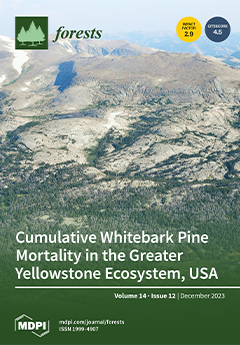The effect of pruning treatments on growth, photosynthesis characteristics, and metabolites were was studied in
Eucommia ulmoides Oliver (
E. ulmoides). The experiment was carried out from March–August 2019. Three treatments were used: non-pruned trees (CK), a height of 20 cm above the top edge of the flowerpot (T1), and a height of 10 cm above the top edge of the flowerpot (T2). The results showed that the branches branch number, leaves leaf number, and stem diameter increased significantly (
p < 0.05) in pruning treatments compared with CK. Similarly, the net photosynthetic rate (Pn), stomatal conductance (Gs), transpiration rate (Tr), maximum photosynthetic efficiency (Fv/Fm), and non-photochemical quenching coefficient (NPQ) increased significantly in pruning treatments (
p < 0.05). Interestingly, the contents of Chl
a, Chl
b, Chl, Car, and the rate between the Chl
a content and the Chl
b content increased significantly (
p < 0.05) in T2, respectively. These verified that it was a better way to enhance the plants growth of
E. ulmoides for pruning treatments. The GC-MS analysis showed that 36 different primary metabolites were identified, including 11 sugars, 13 acids, 5 alcohols, and 7 other compounds, the relative content of their metabolites were was higher in the T2 treatment than that in the T1 treatment, which was mainly concentrated in four main enrichment pathways (Galactose metabolism; Citrate cycle; Glyoxylate and dicarboxylate metabolism; and starch and sucrose metabolism) via KEGG analysis. Meanwhile, correlation analysis showed there were was a positive correlation between the accumulation of D-Galactose, D-Mannose, Succinic acid, and photosynthetic pigment content, and the rate of photosynthesis in T2 treatment (
p < 0.05). The pruning height above the top edge of the flowerpot changed the accumulation of primary metabolites and promoted plant regeneration ability in
E. ulmoides. Finally, the yield of main secondary metabolites from leaves (Genipin, Geniposide, Geniposidic acid, and Pinoresinol diglucoside) were was increased in pruning treatments by UPLC analysis. It provided a reference for the directional ecological cultivation of
E. ulmoides.
Full article





